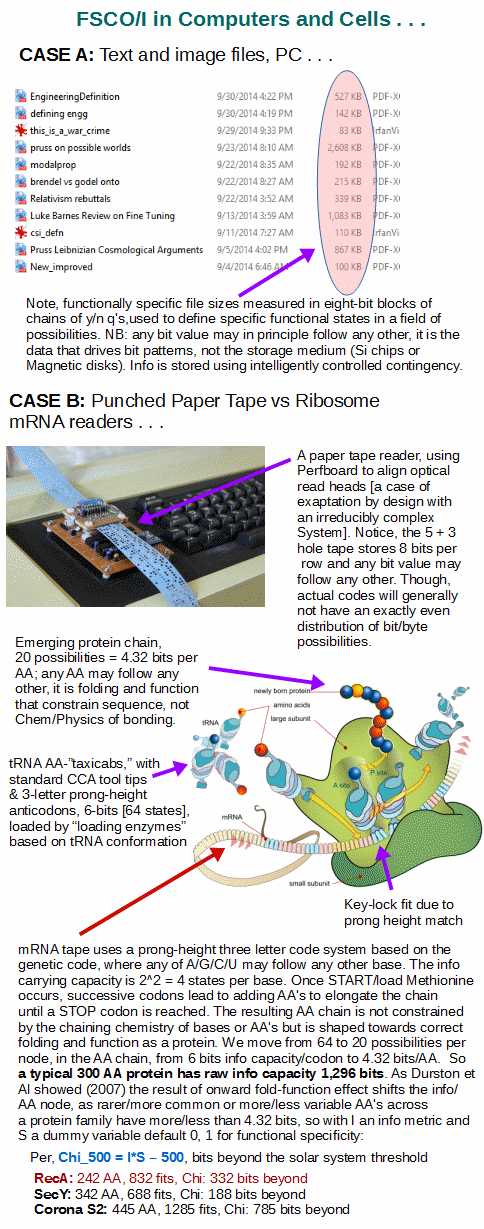In the face of confusing, accusatory, polarising and dismissive rhetoric emanating from all too many objectors to design thought in our day, it is useful to put on record the core design view and the pivotal design inference as a marker for reasonable discussion. That is, a key current task is to clear the air of obfuscating, polarising, ill informed and/or confusing or misleading and/or manipulative polarising rhetoric projected by objectors to modern design thought.
First, the modern, scientific design view can be reasonably summarised in words from the NWE article on Intelligent Design:
Intelligent design (ID) is the view that it is possible to infer from empirical evidence that “certain features of the universe and of living things are best explained by an intelligent cause, not an undirected process such as natural selection” [1] Intelligent design cannot be inferred from complexity alone, since complex patterns often happen by chance. ID focuses on just those sorts of complex patterns that in human experience are produced by a mind that conceives and executes a plan. According to adherents, intelligent design can be detected in the natural laws and structure of the cosmos; it also can be detected in at least some features of living things.
Greater clarity on the topic may be gained from a discussion of what ID is not considered to be by its leading theorists. Intelligent design generally is not defined the same as creationism, with proponents maintaining that ID relies on scientific evidence rather than on Scripture or religious doctrines. ID makes no claims about biblical chronology, and technically a person does not have to believe in God to infer intelligent design in nature. As a theory, ID also does not specify the identity or nature of the designer, so it is not the same as natural theology, which reasons from nature to the existence and attributes of God. ID does not claim that all species of living things were created in their present forms, and it does not claim to provide a complete account of the history of the universe or of living things.
ID also is not considered by its theorists to be an “argument from ignorance”; that is, intelligent design is not to be inferred simply on the basis that the cause of something is unknown (any more than a person accused of willful intent can be convicted without evidence). According to various adherents, ID does not claim that design must be optimal; something may be intelligently designed even if it is flawed (as are many objects made by humans).
ID may be considered to consist only of the minimal assertion that it is possible to infer from empirical evidence that some features of the natural world are best explained by an intelligent agent. It conflicts with views claiming that there is no real design in the cosmos (e.g., materialistic philosophy) or in living things (e.g., Darwinian evolution) or that design, though real, is undetectable (e.g., some forms of theistic evolution). Because of such conflicts, ID has generated considerable controversy . . .
Obviously, this position is not based on religious traditions or texts (it is certainly not “Creationism in a cheap tuxedo” and it is most certainly not created post 1987 to get around US Supreme Court rulings, as it dates from the turn of the 1980’s and was formulated in its first technical book, The Mystery of Life’s Origin by Thaxton et al, by 1984), and traces to the classical thought of people such as Plato, in remarks such as these from The Laws Book X:
Ath. . . . we have . . . lighted on a strange doctrine.
Cle. What doctrine do you mean?
Ath. The wisest of all doctrines, in the opinion of many.
Cle. I wish that you would speak plainer.
Ath. The doctrine that all things do become, have become, and will become, some by nature, some by art, and some by chance.
Cle. Is not that true?
Ath. Well, philosophers are probably right; at any rate we may as well follow in their track, and examine what is the meaning of them and their disciples.
Cle. By all means.
Ath. They say that the greatest and fairest things are the work of nature and of chance, the lesser of art, which, receiving from nature the greater and primeval creations, moulds and fashions all those lesser works which are generally termed artificial . . . . . fire and water, and earth and air, all exist by nature and chance . . . The elements are severally moved by chance and some inherent force according to certain affinities among them . . . After this fashion and in this manner the whole heaven has been created, and all that is in the heaven, as well as animals and all plants, and all the seasons come from these elements, not by the action of mind, as they say, or of any God, or from art, but as I was saying, by nature and chance only . . . . Nearly all of them, my friends, seem to be ignorant of the nature and power of the soul [i.e. mind], especially in what relates to her origin: they do not know that she is among the first of things, and before all bodies, and is the chief author of their changes and transpositions. And if this is true, and if the soul is older than the body, must not the things which are of the soul’s kindred be of necessity prior to those which appertain to the body? . . . . if the soul turn out to be the primeval element, and not fire or air, then in the truest sense and beyond other things the soul may be said to exist by nature; and this would be true if you proved that the soul is older than the body, but not otherwise. [Emphases added]
That is it is a long held view that we may explain occurrences, objects and effects causally based on chance, and/or necessity and/or design, with mechanical necessity manifesting highly repeatable regularities under given initial conditions [drop a rock], chance often yielding stochastically distributed contingent outcomes [toss a die] and design arising from intelligently directed contingency and showing itself in commonly recognised signs of intelligent action.
Many years later, Newton, in his General Scholium to his Principia, the book that presented the laws of motion and gravitation, argued in the wider context of his theistic view of the world, supporting the distinctions made above and making a cosmological design inference:
Blind metaphysical necessity, which is certainly the same always and every where, could produce no variety of things. [i.e necessity does not produce contingency] All that diversity of natural things which we find suited to different times and places could arise from nothing but the ideas and will of a Being necessarily existing. [That is, implicitly rejects chance, Plato’s third alternative and explicitly infers to the Designer of the Cosmos.]
In more recent years, the Nobel-equivalent prize holding astrophysicist and lifelong atheist/agnostic — sometimes it is hard to distinguish the two because of overlapping definitions and frames of thought — Sir Fred Hoyle, would publicly argue:
Once we see that life is cosmic it is sensible to suppose that intelligence is cosmic. Now problems of order, such as the sequences of amino acids in the chains which constitute the enzymes and other proteins, are precisely the problems that become easy once a directed intelligence enters the picture, as was recognised long ago by James Clerk Maxwell in his invention of what is known in physics as the Maxwell demon. The difference between an intelligent ordering, whether of words, fruit boxes, amino acids, or the Rubik cube, and merely random shufflings can be fantastically large, even as large as a number that would fill the whole volume of Shakespeare’s plays with its zeros. So if one proceeds directly and straightforwardly in this matter, without being deflected by a fear of incurring the wrath of scientific opinion, one arrives at the conclusion that biomaterials with their amazing measure or order must be the outcome of intelligent design. No other possibility I have been able to think of in pondering this issue over quite a long time seems to me to have anything like as high a possibility of being true.” [[Evolution from Space (The Omni Lecture[ –> Jan 12th 1982]), Enslow Publishers, 1982, pg. 28.]
That is not all that he argued either, in a 1981 Caltech talk he said the now somewhat famous words:
From 1953 onward, Willy Fowler and I have always been intrigued by the remarkable relation of the 7.65 MeV energy level in the nucleus of 12 C to the 7.12 MeV level in 16 O. If you wanted to produce carbon and oxygen in roughly equal quantities by stellar nucleosynthesis, these are the two levels you would have to fix, and your fixing would have to be just where these levels are actually found to be. Another put-up job? . . . I am inclined to think so. A common sense interpretation of the facts suggests that a super intellect has “monkeyed” with the physics as well as the chemistry and biology, and there are no blind forces worth speaking about in nature. [F. Hoyle, Annual Review of Astronomy and Astrophysics, 20 (1982): 16.]
He also said in that talk:
The big problem in biology, as I see it, is to understand the origin of the information carried by the explicit structures of biomolecules. The issue isn’t so much the rather crude fact that a protein consists of a chain of amino acids linked together in a certain way, but that the explicit ordering of the amino acids endows the chain with remarkable properties, which other orderings wouldn’t give. The case of the enzymes is well known . . . If amino acids were linked at random, there would be a vast number of arrange-ments that would be useless in serving the pur-poses of a living cell. When you consider that a typical enzyme has a chain of perhaps 200 links and that there are 20 possibilities for each link,it’s easy to see that the number of useless arrangements is enormous, more than the number of atoms in all the galaxies visible in the largest telescopes. This is for one enzyme, and there are upwards of 2000 of them, mainly serving very different purposes. So how did the situation get to where we find it to be? This is, as I see it, the biological problem – the information problem . . . .
I was constantly plagued by the thought that the number of ways in which even a single enzyme could be wrongly constructed was greater than the number of all the atoms in the universe. So try as I would, I couldn’t convince myself that even the whole universe would be sufficient to find life by random processes – by what are called the blind forces of nature . . . . By far the simplest way to arrive at the correct sequences of amino acids in the enzymes would be by thought, not by random processes . . . .
Now imagine yourself as a superintellect working through possibilities in polymer chemistry. Would you not be astonished that polymers based on the carbon atom turned out in your calculations to have the remarkable properties of the enzymes and other biomolecules? Would you not be bowled over in surprise to find that a living cell was a feasible construct? Would you not say to yourself, in whatever language supercalculating intellects use: Some supercalculating intellect must have designed the properties of the carbon atom, otherwise the chance of my finding such an atom through the blind forces of nature would be utterly minuscule. Of course you would, and if you were a sensible superintellect you would conclude that the carbon atom is a fix.
Nor is that all that he had to say in the same talk:
I do not believe that any physicist who examined the evidence could fail to draw the inference that the laws of nuclear physics have been deliberately designed with regard to the consequences they produce within stars. [“The Universe: Past and Present Reflections.” Engineering and Science, November, 1981. pp. 8–12]
Indeed, the first of these cites is arguably the root of the modern use of the term, intelligent design.
So, plainly, this is not a matter of theism or theistic question-begging and impositions on scientifically oriented, inductive reasoning. (And, BTW, on the world of observed cell based life, from the early 1980’s on, scientists and thinkers associated with modern design thinking have vary carefully refrained from making the leap of inference from design of life on empirically grounded signs, to the identification of a particular candidate designer as the designer. But as Sir Fred Hoyle’s points highlight, power and smarts to design a fine tuned cosmos fitted to such life make for a very different set of considerations on candidate designers. It is in that context that I find it a bit odd that so much of the contentious debate over design inferences regarding the natural world focuses on the world of life.)
But, just what is that design inference and how is it justified as an inductive reasoning, scientifically focused exercise?
The design inference, per aspect explanatory filter can help us understand:
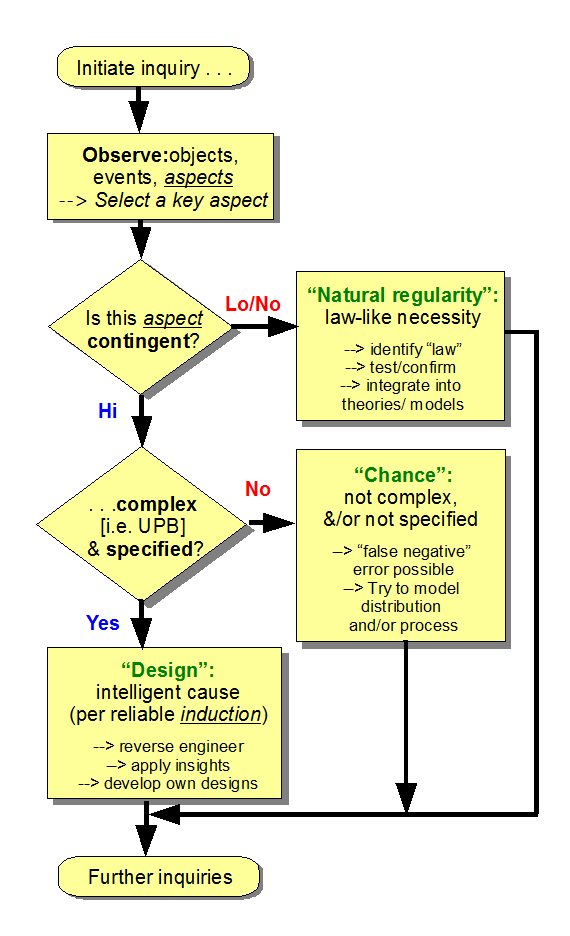 Here, the generally accepted relevant trichotomy of causal factors is analysed aspect by aspect of an object, process, phenomenon or whatever, with law-like mechanical necessity the first default. If there is instead high contingency under similar initial circumstances, the two known sources of such high contingency are brought to bear. Again, chance is default, with only those cases that pass a joint complexity-specificity criterion being inferred as designed in light of the following needle in haystack analysis. Where in a configuration space W, any given particular configuration P or E etc will have degrees of freedom/ specifying variables / dimensions x1, x2 . . . xn, e.g. a specified part for a fishing reel (that in itself requires identification along lines of 20-questions, per, animal, vegetable or mineral, etc) may undergo yaw pitch and roll — 3 dimensions already — relative to a coordinate axis, has a location in 3-d space — another three — and is joined or coupled to other parts in a specific wiring diagram pattern [which may require several additional dimensions]:
Here, the generally accepted relevant trichotomy of causal factors is analysed aspect by aspect of an object, process, phenomenon or whatever, with law-like mechanical necessity the first default. If there is instead high contingency under similar initial circumstances, the two known sources of such high contingency are brought to bear. Again, chance is default, with only those cases that pass a joint complexity-specificity criterion being inferred as designed in light of the following needle in haystack analysis. Where in a configuration space W, any given particular configuration P or E etc will have degrees of freedom/ specifying variables / dimensions x1, x2 . . . xn, e.g. a specified part for a fishing reel (that in itself requires identification along lines of 20-questions, per, animal, vegetable or mineral, etc) may undergo yaw pitch and roll — 3 dimensions already — relative to a coordinate axis, has a location in 3-d space — another three — and is joined or coupled to other parts in a specific wiring diagram pattern [which may require several additional dimensions]:
Or, more broadly (and including cases from the world of cell based life –BTW, while illustrating just how commonplace measures of functionally specific complex information are):
Thus, we can picture the abstract space and the needle in haystack challenge to blindly find complex, functionally specific configurations based on those co-ordinates:
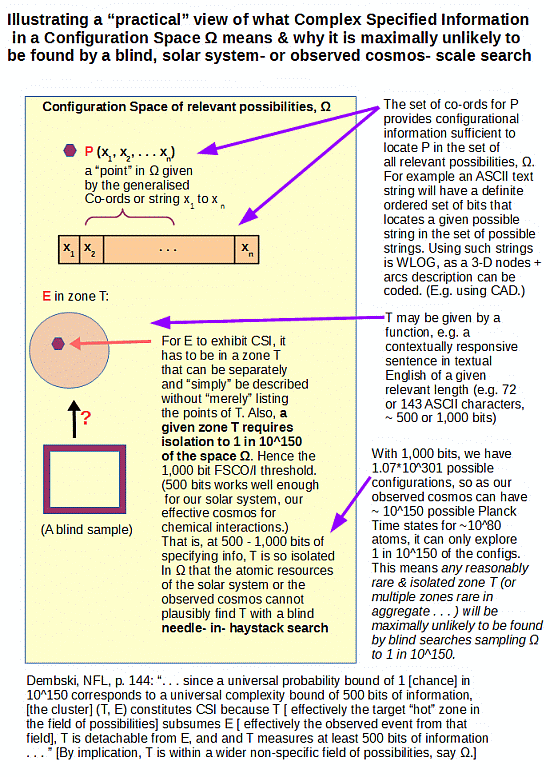 That is, we are analysing based on the dynamic-stochastic system view often used in Monte Carlo analysis:
That is, we are analysing based on the dynamic-stochastic system view often used in Monte Carlo analysis:
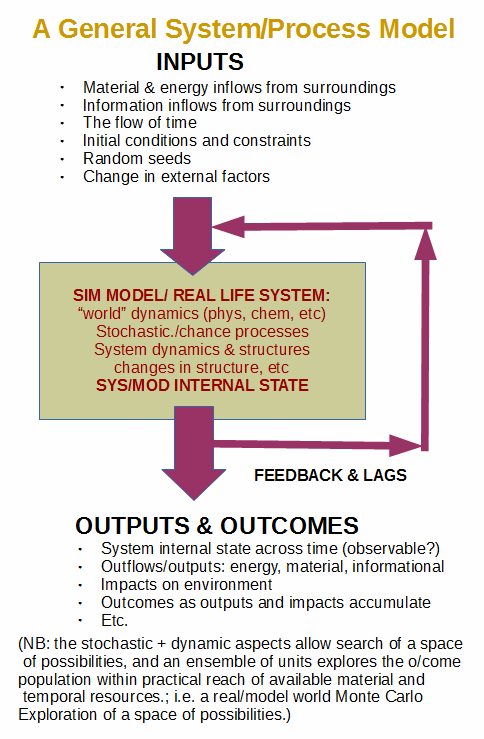 And, as a comparison challenge, we use the idea of converting the 10^57 or so atoms of our sol system into a giant config search machine for the space of 500 coins, which allows us to understand just how tiny is the scope of blind search to space, making it utterly implausible to find isolated zones T — often, Islands of Function — through such searches. Where, the requisites of function as shown for the Abu 6500 C3 reel, require tight clusters of possible arrangements (there are tolerances and the like) out of the set of possible clumped or scattered arrangements of the same parts. Only a tiny fraction of possible arrangements will hold line, lay it evenly, freespool, cast line, magnetically brake it to reduce odds of backlashes, lock back, retrieve, and exert controllable slipping clutch drag etc. So, it is reasonable to compare:
And, as a comparison challenge, we use the idea of converting the 10^57 or so atoms of our sol system into a giant config search machine for the space of 500 coins, which allows us to understand just how tiny is the scope of blind search to space, making it utterly implausible to find isolated zones T — often, Islands of Function — through such searches. Where, the requisites of function as shown for the Abu 6500 C3 reel, require tight clusters of possible arrangements (there are tolerances and the like) out of the set of possible clumped or scattered arrangements of the same parts. Only a tiny fraction of possible arrangements will hold line, lay it evenly, freespool, cast line, magnetically brake it to reduce odds of backlashes, lock back, retrieve, and exert controllable slipping clutch drag etc. So, it is reasonable to compare:
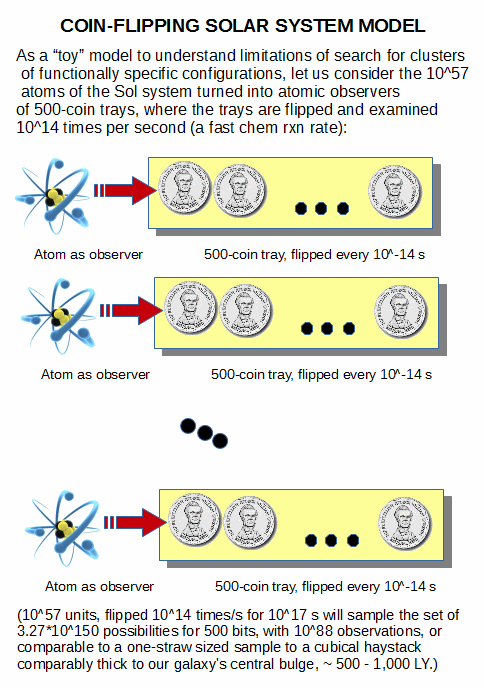 But, we may explain the inference and its underlying logic in another way, as I did here this morning (and decided to make into an FTR before I turn aside to write an emergency request executive & action summary):
But, we may explain the inference and its underlying logic in another way, as I did here this morning (and decided to make into an FTR before I turn aside to write an emergency request executive & action summary):
A sounder approach [than that of the selective hyperskepticism as is unfortunately commonly used by objectors to design thought] would be to reckon that in inductive, evidence and observation anchored reasoning on origins, the deep past is not open to direct inspection. So, we must infer on traces per inference to best current explanation. Which in turn points to needing to have observational demonstration that claimed causal factors can and do in our observation have relevant capacity to cause substantially similar results or effects and that cumulatively we have sufficiently discriminatory tests to confirm any one account.
We may observe, reason inductively, argue and conclude:
a: Apart from a priori materialism, which begs the question,
b: there is simply zero current credible empirical, observational evidence that
c: functionally specific, complex organisation and/or associated information manifested in node-arc structures where correctly arranged and coupled components interact to achieve the functional effect in view beyond 500 – 1,000 bits of complexity [FSCO/I for short],
d: i.e.. the node-arcs pattern requires at least 500 – 1,000 y/n q’s to specify it in its configs space,
e: can and does arise from blind, non-foresighted chance contingency and/or mere mechanical necessity, but
f: there are trillions of cases that routinely — e.g. posts in this thread add to the number — show that such FSCO/I commonly and easily observably does arise from intelligently directed contingency or configuration or contrivance, i.e. by design. Therefore,
g: on inference to best current, empirically grounded explanation,
h: such FSCO/I is an inductively reliable sign of design as cause, passing the vera causa — true cause — test. Thus,
i: the abundant FSCO/I in the world of life strongly, inductively, points to design as empirically credible cause. that is,
j: From root to uppermost twigs, there is good inductive reason to hold the scientific view that the world of life is chock full of strong signs — not merely appearances — of design.
This, in a nutshell, is the core design case concerning the world of life. There is another, relating to the fine tuning of the observed cosmos that sets up that world of life.
So, we need to be clear just what design thought and the design inference are about.
There being an open thread for discussion here onwards, this will be FTR. END

